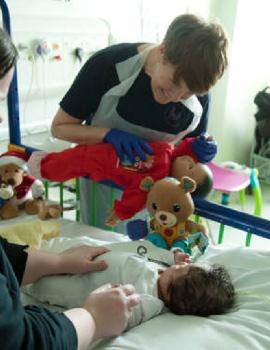The Work with Infants

(photos courtesy of The Royal London Hospital)
My name is Liz Thompson and I am a baby massage and mother and baby yoga instructor. I have just completed a year long project at the Royal London Hospital, Barts Health NHS Trust and I have been asked to share my experience with you. The project was the vision of Lucy Wootton, Lead of the Royal London Hospital Play Department and dedicated yoga enthusiast. Lucy wanted to improve the Play Department’s services for their most vulnerable patients, babies from 6 weeks to 2 years of age in long term hospital inpatient care. Lucy wanted to support baby-parent bonding and attachment, build parents’ confidence in caring for their babies, help parents recognise their babies’ cues and reduce patient and parent/carer stress. The needs that Lucy identified formed the aims of the project.
After much problem solving, emails, discussions, meetings, trial sessions and a super detailed background check, our audit was ready to go. We bought a new doll for hygiene control, promoted the service by speaking to staff and parents alike and began weekly baby massage and yoga sessions. I was accompanied and supported by a Play Specialist and I can’t praise the Play Team enough, they are amazing.
Initially we held a group class in a communal space called The Healing Space. Many patients wanted to attend but were too unwell to leave their rooms or wards so bedside visits became the norm. All visits were individualised, patient led and lasted between 10-20 minutes to enable us to access as many patients as possible.
ome visits focused on positive touch with resting hands, songs or gentle massage. Other visits incorporated yoga moves, breath and body awareness or relaxation exercises. No two visits were the same. All sessions were patient led with parent participation being key. Permission was always asked from the patient beforehand and the patient was always thanked afterwards. If a patient was asleep, we offered the session to the parent. Without exception, the sessions enabled the patient and parent to unite in a more relaxed and connected space.
Many of the patients involved in the project had been in hospital for more than a year and I got to know them well. Some patients I only met once before they were discharged or transferred to other hospitals. Often patients would be discharged only to be readmitted a few weeks later. These patients and parents appeared to welcome the familiarity of our sessions. Many of our visits involved one parent and patient in a room while in other rooms there would be a whole family visiting. No matter what the situation, everyone was always included.
During this project Janelyn Ong, a medical student at Queen Mary University of London (QMUL) conducted an audit with assistance from the Play Department. The audit aimed to assess the effectiveness of baby yoga and massage classes on reducing patient and caregiver stress. The audit took place between November 2017 and May 2018. In total 28 questionnaires were collected and analysed.
“The audit aimed to assess the effectiveness of baby yoga and massage classes on reducing patient and caregiver stress”
Part of the audit was a requirement for parents to complete a questionnaire before and after their session. Many parents did not speak English or have English as their their first language so this was quite a challenge. Luckily, for the sessions, our massage and yoga doll proved such a good model that a language barrier was not a problem.
The results from the audit suggested significant reductions in patients and caregivers stress levels when comparing mood pre and post baby massage and yoga sessions. The most significant results were:
- Reductions in caregivers stress and they reported feeling better able to cope with their children following sessions
- 9.5 out of 10 parents questioned reported that they would recommend the service to others
- When asked ‘How helpful is ‘parent and baby massage and yoga’ in reducing your child’s stress level?’ parents have responded with an average of 8.47 out of 10.